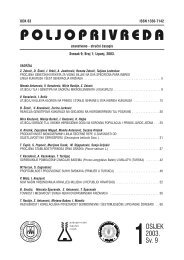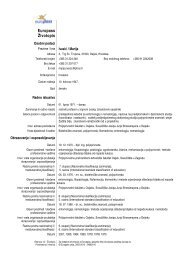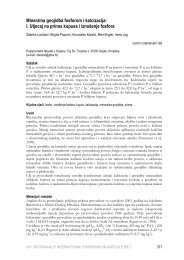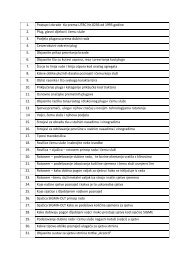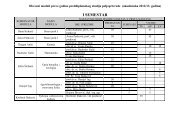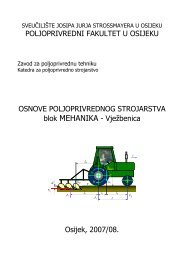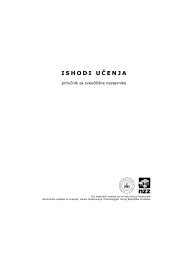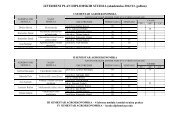Poljoprivreda 2-2006 final.qxd
Poljoprivreda 2-2006 final.qxd
Poljoprivreda 2-2006 final.qxd
You also want an ePaper? Increase the reach of your titles
YUMPU automatically turns print PDFs into web optimized ePapers that Google loves.
18<br />
A. Sudarić et. al.: EVALUATION OF AGRONOMIC PERFORMANCE OF DOMESTIC AND ...<br />
data are readily available from yield performance tests.<br />
The genetic diversity of selected parents has great<br />
impact on the rate of further genetic improvement of<br />
cultivars. The lower rate may be associated with the<br />
limited amount of genetic diversity among the high-yielding<br />
cultivars used as parents for hybridization. Burton<br />
(1997) reported that elite parents of diverse origin are<br />
more likely to produce progeny superior to either parent<br />
than parents of similar ancestry. According to this<br />
aspect of breeding work, collaboration and interchange<br />
of breeding materials between breeding programs<br />
worldwide is necessary and important to increase the<br />
amount of genetic diversity by incorporating unique exotic<br />
germplasm into existing domestic germplasm. Thus,<br />
within the framework of a scientific collaboration between<br />
soybean breeding programs of the Agricultural<br />
Institute Osijek and the University of Guelph (Canada) a<br />
number of registered cultivars have been exchanged.<br />
The objective of this study was to evaluate agronomic<br />
performance of exotic, Canadian cultivars in comparison<br />
with domestic cultivars through multi-environment<br />
trials. The results will enable us to identify the<br />
most favorable parental combinations of the domestic<br />
and Canadian cultivars. The utilization of foreign germplasm<br />
in hybridization will contribute to increasing the<br />
amount of genetic diversity leading to the development<br />
of segregating populations from which new, genetically<br />
more diverse and improved lines could be released.<br />
MATERIAL AND METHODS<br />
The research was conducted at the experimental<br />
field of the Agricultural Institute Osijek (Osijek, Croatia)<br />
during the period from 2002 to 2005. Experimental material<br />
consisted of 30 released soybean cultivars of which<br />
15 cultivars in the group named OS-cultivars (Mura, Iva,<br />
Kruna, Una, Anica, Nada, Bara, Kuna, Nika, Ika, Podravka<br />
95, Drina, Tisa, Ilova, Smiljana) originated from the soybean<br />
breeding program at the Agricultural Institute<br />
Osijek and 15 cultivars in the group named CA-cultivars<br />
(OAC Erin, OAC Brussels, OAC Millennium, OAC<br />
Lucknow, OAC Oxford, OAC Morris, OAC Champion,<br />
OAC Bayfield, OAC Clinton, OAC Arthur, OAC Exeter,<br />
OAC Stratford, OAC Auburn, OAC Wallace, RCAT<br />
Bobcat) were developed by the soybean breeding program<br />
at the University of Guelph, Canada. Field trials<br />
were designed as a randomized complete block with four<br />
replications. Plot size was 9m 2 and plots consisted of 4<br />
rows, 5 m long, with row spacing of 0.45m. The experimental<br />
plots were sown by precise planting machine in<br />
optimal time for soybean. Currently used management<br />
and cultural practices for soybean were applied in all<br />
field performance trials. During the growing period, the<br />
experimental material was evaluated for phenological<br />
phases, lodging resistance (on a scale from 0 to 5) as<br />
well as occurrence and intensity of diseases. The first<br />
evaluation of diseases was done at R2 stage for downy<br />
mildew (Peronospora manshurica (NAOUM.) Syd. ex<br />
Gaum) and second one at R6-R7 stages for late-occurring<br />
soybean diseases. Diseases severity was evaluated<br />
on a scale from 0 to 9. At maturity, 30 plants per plot<br />
were randomly selected, i.e. each cultivar per experimental<br />
year was represented by a sample consisting of<br />
120 plants. Plots were harvested with small plot harvest<br />
combine, when cultivars reached full harvest maturity.<br />
Seed harvested from each plot was recorded in kilograms<br />
per plot and converted to kilograms per hectare at<br />
13% seed moisture. In the Institute’s laboratory, grain<br />
yield components and incidence of downy mildew on<br />
seed were measured and evaluated, respectively. Two<br />
100 seed sampled were used from each seed lot to<br />
check for incidence of fungus crusts under stereo binocular.<br />
A number of infected seeds was expressed as a<br />
percentage. The experimental data were analyzed by<br />
two-factor ANOVA (genotype and year, as main effects)<br />
and Least Significant Difference (LSD) test with the<br />
general linear models procedure (GLM) of the SAS software<br />
package (SAS, 2001). ANOVA was used to test the<br />
significance of interaction between genotype and year<br />
(environment) effect (GEI), which was used to calculate<br />
and analyze stability and adaptability. Stability analyses<br />
of grain yield as well as adaptability of tested materials<br />
were performed by the combination of two parameters:<br />
S 2 GxE<br />
– portion of GEI variance of each genotype to total<br />
variance of GEI and b i<br />
– regression coefficient (Finlay and<br />
Wilkinson, 1963). According to Plasteid and Peterson’s<br />
method (1959), if GEI portion of single genotype in total<br />
GEI (S 2 GxE<br />
) is less, stability of genotype is higher and<br />
inverse. Regression coefficient represents specific reaction<br />
of a genotype to environmental conditions. Lin and<br />
Binns (1985) reported that genotypes with a b i<br />
value<br />
1.3 are considered<br />
responsive to good environments, having below-average<br />
stability and adaptability to high-yielding environments.<br />
According to Lin et al. (1986) the stability statistics<br />
applied in this study represents the Type 2 concept of<br />
stability: a genotype is considered stable if its response<br />
to environments is parallel to the mean response of all<br />
genotypes in the trial. If agronomic stability is demonstrated<br />
for a wide range of environments, a genotype is<br />
defined as having general or wide adaptation.<br />
Conversely, if agronomic stability is manifested over a<br />
limited range, a genotype has specific or narrow adaptation.<br />
Estimated parameters enabled grouping tested<br />
materials in consideration of their genetic potential and<br />
stability of grain yield as well as level of adaptability. The<br />
soil type at the experimental site was classified as a<br />
eutric cambisol (Škorić, 1973). The chemical soil properties<br />
were: pH 7.00 (H 2<br />
O); humus 1.83%; N org20<br />
2.34<br />
mg/100g of soil; K 20<br />
13.46 mg/100g of soil; P 20<br />
3.39<br />
mg/100g of soil (EUF method). Meteorological data<br />
(monthly mean air temperature and monthly total preci-<br />
POLJOPRIVREDA 12:<strong>2006</strong> (2) 17-22



